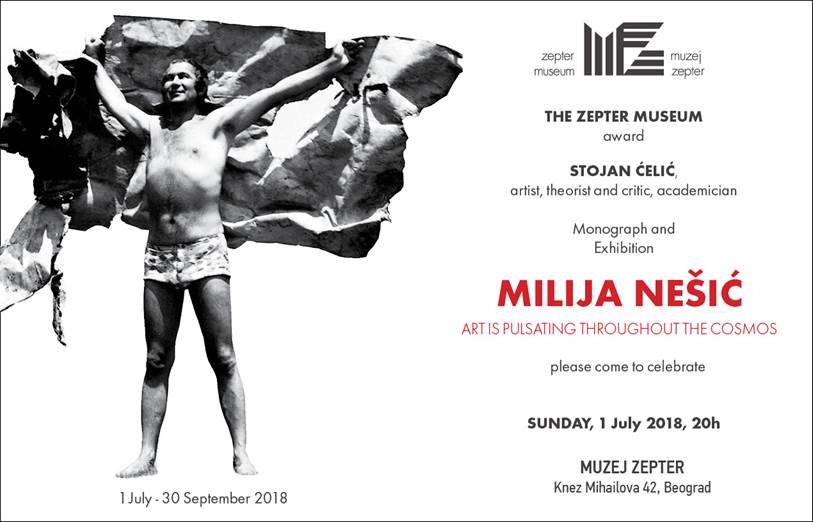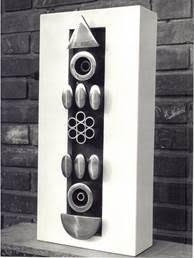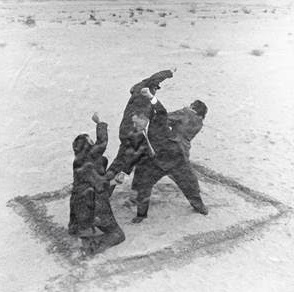 He was born in 1934. With his father, mother and two brothers he spent his early childhood in the suburbs of Niš. During the Second World War the family moved to his grandfather’s estate in the village of Bresničići, near Prokuplje; his first „sculptures“ were made there. In 1950 he was a high-school student in Niš. The scene he noticed one day over the wall around the school yard defined his further destiny. He saw then white oversized classical sculptures in the autumn sun, drawn by the students of the Secondary Art School. Nešić joined them one month later, after he had obtained the permission of the Republican Ministry of Education and passed the specially organised entrance exam. When he was in the final year of the Secondary Art School Nešić made a sculpture in plaster, over five meters high, entitled Rebuilding, Industry, Culture of the City of Niš.
He was born in 1934. With his father, mother and two brothers he spent his early childhood in the suburbs of Niš. During the Second World War the family moved to his grandfather’s estate in the village of Bresničići, near Prokuplje; his first „sculptures“ were made there. In 1950 he was a high-school student in Niš. The scene he noticed one day over the wall around the school yard defined his further destiny. He saw then white oversized classical sculptures in the autumn sun, drawn by the students of the Secondary Art School. Nešić joined them one month later, after he had obtained the permission of the Republican Ministry of Education and passed the specially organised entrance exam. When he was in the final year of the Secondary Art School Nešić made a sculpture in plaster, over five meters high, entitled Rebuilding, Industry, Culture of the City of Niš.
In 1956 he enrolled the Academy (presently Faculty) of Fine Arts in Belgrade, Department of Sculpture, and on June 1964, after having passed all the exams and defended the previously satisfactorily appraised practical work he received the M.A. title.
He dedicated his entire life to art working as a free-lance artist in Belgrade, where he still lives. His first salary, as he wittily says, was his old age pension obtained after many decades of hard life dedicated to art.
His biography is replete with artistic contents because Nešić was a versatile artist engaged (we use past tense here because in this advanced age he is now only assembling impressions from his past life and work) in sculpture, performance, photography, objects, paintings, drawings and writing.
As a young sculptor he was well received and acknowledged (he got awards and official recognitions as well as positive professional reviews for his works), and then came the period when he was totally absent from the focus of art critics and was almost forgotten.
An important part of Milija Nešić’s rich and diverse opus remained in the shadow of the former as well as later creative activity. In between his URBAN-CONCRETE SCULPTURES (from mid-sixties and the second half of the same decade) and MOTILES (the first solo EXHIBITION OF MOTILES in the Gallery of the Cultural Centre of Belgrade was in 1979), Nešić was one of the pioneers of performance art with his actions of the sand of New Belgrade (1972-1976).
The cycle of URBAN-CONCRETE SCULPTURES was not only appreciated then in Yugoslavia but also received international recognition. Still, this sculpture conceived as monumental and not reduced to gallery format, was never realised according to the artist’s conception (except in rare instances when he participated in the exhibitions SPACE or the symposia of sculptors). In the notebooks he still keeps there are numerous drawings he called My Imaginary World – Unrealised Dreams.
With his performances on the sand Milija Nešić is classified as an avant-garde artist, but outside the group of young artists gathered in the seventies around the Student Cultural Centre who had public and institutional support. Nešić was then working on the margin, alone in his researches and without any professional or public support. His works from that period have not been recognised.
The proposal to name Milija Nešić as the second recipient of the award STOJAN ĆELIĆ, artist, critic and theorist, academician, which the ZEPTER MUSEUM established in 2014, was strengthened by the desire to make a thorough research of his entire output and to draw the attention of the professionals to this creative adventure of Milija Nešić, not only because of the artistic achievements but also because of the strong social commitment of these works.
For a long time, and even today, the general public has recognised Milija Nešić only by his motiles. However, within the enormous opus of the motiles, that antiform as the author calls them, there are numerous indications of social anomalies, warnings and critique.
The exhibition MILIJA NEŠIĆ – THE ART IS PULSATING THROUGH THE COSMOS and the monograph study on the artist published on this occasion will present the artist’s entire opus which has lasted for many decades.
The authors of the monograph study are art historians Ivana Simeonović Ćelić and Savo Popović and its launching has been set for September.
 |
 |
| PREDMET IDEJE 6 / THE OBJECT OF AN IDEA 6, 1968 čelik i bojeni lim / steel and painted tin |
HOMO DUPLEX, 1992 panel, šper ploča, boja, najlon / pressed wood, plywood,paint, nylon |
 |
||
| BORBA ZA PROSTOR / STRUGGLE FOR SPACE Iz opusa ŽIVOT, PROSTOR, VREME / From the cycle LIFE, SPACE, TIME, 1972-1976 |

